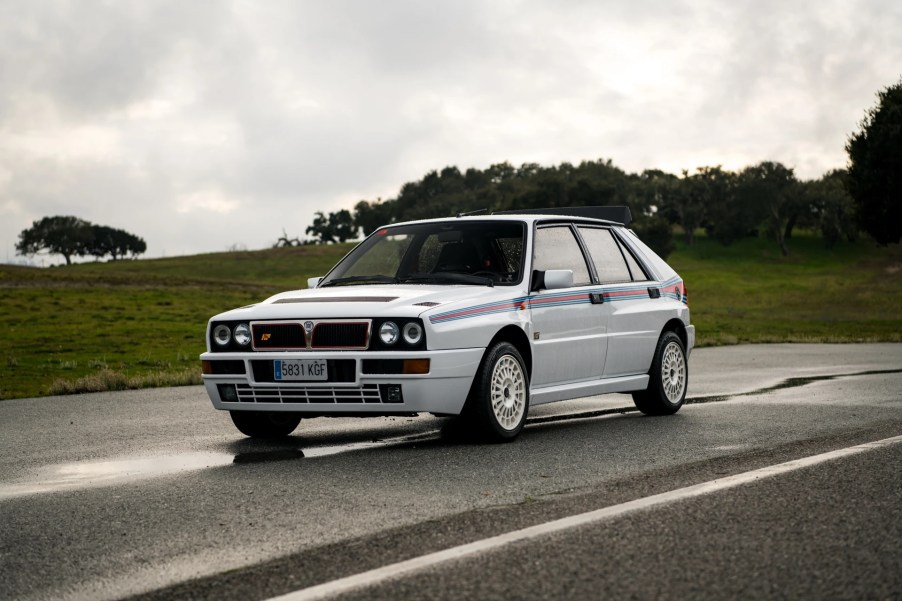
The Lancia Delta Integrale May Be the Ultimate Hot Hatch
Today, turbochargers are a standard part of the hot hatch formula. And some of the hottest, like the Golf R, rely on all-wheel drive for greater speed and traction. Both helped start the legends of cars like the Audi Ur-Quattro, Subaru WRX, and Mitsubishi Lancer Evo. But all 3 were hard-pressed to keep up with another rally great. A hot hatch that combined AWD and turbos decades before the Golf R: the Lancia Delta Integrale.
The Lancia Delta Integrale’s winning formula

Lancia is one of the most successful brands at rallying. The Italian company was the first to create a purpose-built rally car, the Stratos. But it was the later Delta Integrale that was its most successful racer.
It won the World Rally Championship 6 years in a row, from 1987-1992, Petrolicious reports. No car before or since has equaled this feat. This is incredible considering, as ISSIMI explains below, it wasn’t actually intended for rallying. In fact, when it went racing, the hatchback was already 7 years old.
Originally, Lancia raced in Group B using the AWD Delta S4. However, that was a Delta in name only, Hagerty reports. Underneath, it had a custom chassis, and a mid-mounted turbocharged and supercharged engine. But when Group B was canceled, Lancia had to quickly find another car to race.
Luckily, there was already an AWD version of the Lancia Delta, the HF 4WD. Which, with its rear Torsen limited-slip differential, was fairly advanced for the time, Classic & Sports Car reports. So, Lancia boosted the 2.0-liter turbocharged four-cylinder from 160 to 195 hp, increased the hood’s ventilation, and gave it wider wheels and tires. The result was the 1987 Lancia Delta Integrale 8v.
What’s it like to drive today?
From then until 1993, Lancia continually improved the Delta Integrale. The 2.0-liter gained fuel injection, more valves, and more power. The AWD system was upgraded and re-configured. The tires and wheels got wider, as did the fender flares. And there were more hood vents and bulges. Though the latter weren’t only for ventilation.

Lancia increased suspension travel over the years. So much so, engineers welded in shock tower extensions, which wouldn’t fit under the original hood. The strut tower braces didn’t help, either.
The last Lancia Delta Integrale that raced in WRC, 1992’s Evoluzione I, made 210 hp. The 1993-94 Evoluzione 2 was the last Delta Integrale, and it made 215 hp.
The Lancia Delta Integrale shows its age in some ways, Automobile reports. The turbocharger has noticeably lag, and there’s a lot of hard plastic in the interior. Due to the lack of airbags, visibility is excellent. But the later models have supportive Recaro sport seats. And while the interior can feel a bit cheap, the driving experience definitely isn’t.
Even today, Evo reports, the Delta Integrale’s AWD system lets it keep up with modern hot hatches. The steering is full of feedback and weighted well—there’s even a radiator specifically for the steering fluid, Petrolicious reports. And the hot hatch’s chassis and suspension make it a balanced and agile car to handle.
Getting your own Lancia Delta Integrale
Although the Lancia Delta Integrale was never sold in the US, it’s now old enough to be import-eligible. In addition, it’s held in high-enough esteem that one company, Automobili Amos, is doing Singer-level Delta Integrale restomods, Road & Track reports.
Being over 25 years old and Italian means finding an un-rusted example can be difficult. However, not only are imports increasing, a fair few come from Japan. Japanese cars tend to be in better condition. Although, there are a few issues to keep in mind. 8-valve models are known to leak oil into the exhaust manifold. Evo 1 models also leak oil, though from their turbos. And 16-valve models are prone to camshaft wear.
It’s worth pointing out that the Delta Integrale burns a bit of oil if driven hard, GarageDreams reports. In addition, the cam belts need to be changed every 12,000-18,000 miles. Luckily, parts for these hot hatches are getting easier to find. FCA is even remaking a few parts as part of its Heritage Department services, Hagerty reports.

Because the Lancia Delta Integrale evolved so much, prices can differ significantly between model years. Also, the Evoluzione models served as the bases for several sought-after special editions. 8-valve and 16-valve models often sell for $20,000-$40,000 on Bring a Trailer. The Evo models, though, typically go for $50,000-$75,000.
That’s quite a lot of money for a hot hatch. But then, the Lancia Delta Integrale isn’t just any hot hatch.
Follow more updates from MotorBiscuit on our Facebook page.


